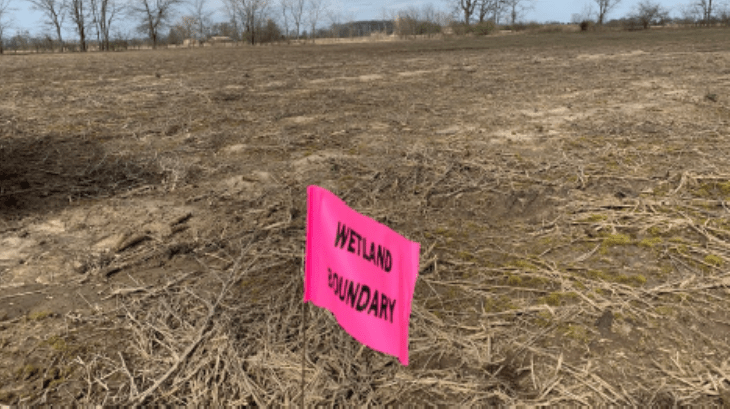
27 Apr General Assembly rolls back regulations on isolated wetlands – Awaits Governor’s action
SEA 389, dealing with state regulated isolated wetlands, passed the Indiana Senate and Indiana House and now heads to the Governor’s desk for final action. Once Governor Holcomb receives the bill in his office, he has seven days to sign the bill, veto the bill, or allow the bill to go into law without his signature.
SEA 389 was authored by Senator Chris Garten (R-Charlestown); Senator Mark Messmer (R-Jasper); Senator Linda Rogers (R-Granger), and 19 co-authors in the Indiana Senate. The lead sponsor in the House was Representative Matt Lehman (R-Berne).
SEA 389 does the following:
- Exempts from permit requirements for the development of cropland that has been used for agricultural purposes within 5 or 10 years, depending on situation
- Exempts permit and mitigation requirements for wetland activities in a Class I wetland that are not subject to regulation under Section 404 of the federal Clean Water Act (CWA)
- Clarifies the definition of a Class II wetland
- Clarifies that a permit is not required in a Class II wetland smaller than 3/8 acre in size (Current law exempts permit requirement for up to ¼ acre in size)
- Makes no change to existing law as it relates to Class III wetlands and mitigation requirements
- Codifies in Indiana Code that wetland activity in an ephemeral stream does not require a permit, unless one is required under the CWA
- Exempts certain wetlands within municipal boundaries
- Establishes a 14-member wetlands task force that will study Indiana’s wetlands and provide a report to the Indiana General Assembly by 11/1/22
SEA 389 received strong support during the legislative process having passed the Indiana Senate (29-19); passed the Indiana House (58-40), and received a concurrence vote in the Senate (31-19) on April 14. SEA 389 strikes a balance between reasonable regulations on property owners with isolated wetlands on their property and protecting the environment.
“While the General Assembly ultimately decided not to mirror the federal standards under the new Waters of the United States (WOTUS) Rule as it relates to isolated wetlands, they did provide some much needed regulatory relief for property owners as it relates to low-quality Class I isolated wetlands in Indiana. This burdensome regulatory scheme has been in place for nearly 20 years and IBA appreciates the willingness of members of the General Assembly to roll-back red tape that will save property owners, farmers, developers, small businesses, and homebuyers’ money for years to come,” commented Rick Wajda, IBA CEO.
“Opponents of this legislation worked hard to destroy the credibility of supporters of SB 389 instead of debating on the merits of the legislation. I appreciate all of the senators and representatives who showed true grit to continue their support for a measure that will help Hoosiers in the long-run from unnecessary regulatory costs,” Wajda further noted.
What is a Class I Isolated Wetland?
Defined in IC 13-11-2-25.8 as:
At least fifty percent (50%) of the wetland has been disturbed or affected by human activity or development by one (1) or more of the following:
- Removal or replacement of the natural vegetation.
- Modification of the natural hydrology.
The wetland supports only minimal wildlife or aquatic habitat or hydrologic function because the wetland does not provide critical habitat for threatened or endangered species listed in accordance with the Endangered Species Act of 1973 (16 U.S.C. 1531 et seq.) and the wetland is characterized by at least one (1) of the following:
- The wetland is typified by low species diversity.
- The wetland contains greater than fifty percent (50%) areal coverage of non-native invasive species of vegetation.
- The wetland does not support significant wildlife or aquatic habitat.
- The wetland does not possess significant hydrologic function.
SEA 389 will provide reasonable regulations for isolated wetlands across the state while keeping housing affordability in mind as the exemption for Class I isolated wetlands will reduce mitigation costs by as much as $120,000 an acre. Mitigation costs are severely hampering economic development projects across the state, including commercial and residential development at a time when we have a need for workforce housing.
Regulations at the federal, state and local level now account for roughly 25% of the cost of a house. This is no sticks or bricks, but government regulations, such as Indiana’s isolated wetlands program, pushing the price of housing up to levels that are becoming out of reach for many Hoosiers. The National Association of Home Builders (NAHB) Economics Department projects that for every $1,000 added to the cost of a house in Indiana, 4,304 Hoosier households are priced out of the market. SEA 389 will help builders and developers bring product to the market at a price they can afford.
SEA 389 will not impact the federal regulation of wetlands in Indiana. Property owners will still be required to comply with Section 404 of the CWA as it relates to federally jurisdictional wetlands. Additionally a CWA Section 401 certification is still required from IDEM demonstrating that the proposed filling of jurisdictional wetlands will not degrade or otherwise violate the state’s water quality standards.
IBA’s mission is to advocate for regulatory and legislative issues that impact housing affordability across our state. IBA is proudly pro-housing and pro-economic development, but more importantly we are pro-Indiana. If Indiana isn’t a great place to live, work, and raise a family, IBA members won’t be selling many houses. Delivering on the wants and needs of the home buying public is a challenge IBA’s members face every day and IBA believes that SEA 389 will help achieve those goals while providing appropriate protections for Indiana’s high-quality wetlands.


Sorry, the comment form is closed at this time.